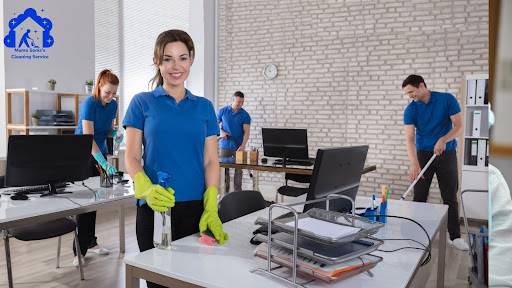Introduction
In today’s fast-paced world, maintaining a hygienic workplace is more critical than ever. With the ongoing emphasis on health and safety, ensuring a clean and healthy work environment is paramount for employee well-being and productivity. This comprehensive guide explores the essential steps for office building cleaning, providing insights into the importance of maintaining workplace hygiene and practical tips for implementation. Let’s dive into the world of office deep cleaning and discover how to make your workplace truly hygienic.
Understanding Office Deep Cleaning
-
The Significance of Office Building Cleaning
Office deep cleaning goes beyond surface-level cleanliness; it encompasses a thorough and systematic approach to removing dirt, grime, and pathogens from every corner of the workspace. By maintaining a clean and hygienic environment, businesses can reduce the risk of illness and absenteeism among employees while fostering a positive and productive work culture.
-
Key Areas of Focus for Office Deep Cleaning
When it comes to office deep cleaning, certain areas require special attention to ensure optimal cleanliness and hygiene. These include high-touch surfaces such as door handles, keyboards, and shared equipment, as well as common areas like reception areas, conference rooms, and break areas. By addressing these key areas, businesses can create a safe and healthy environment for employees and visitors alike.
The Office Deep Cleaning Process
-
Assessing Cleaning Needs
Before embarking on an office deep cleaning initiative, it’s essential to assess the cleaning needs of the workspace. This involves identifying high-traffic areas, assessing the level of cleanliness, and determining the frequency of cleaning required.
-
Developing a Cleaning Plan for Office building cleaning
Once cleaning needs have been assessed, the next step is to develop a comprehensive cleaning plan. This plan should outline the specific tasks to be performed, the frequency of cleaning, and the resources required to execute the plan effectively.
-
Gathering Necessary Equipment and Supplies
With the cleaning plan in place, it’s time to gather the necessary equipment and supplies. This may include cleaning agents, disinfectants, mops, buckets, and protective gear for cleaning staff.
-
Executing the Cleaning Plan
With all the necessary tools and supplies at hand, it’s time to put the cleaning plan into action. This may involve dusting and vacuuming surfaces, disinfecting high-touch areas, and sanitizing restrooms and break areas.
Implementing Hygiene Protocols
-
Establishing Cleaning Schedules
To maintain a clean and hygienic work environment, it’s essential to establish regular cleaning schedules. This ensures that cleaning tasks are performed consistently and on time, minimizing the risk of dirt and germs accumulating over time.
-
Promoting Personal Hygiene Practices for Office building cleaning
In addition to regular cleaning, promoting personal hygiene practices among employees is crucial for maintaining workplace hygiene. This may include providing hand sanitizing stations, encouraging hand washing, and promoting proper respiratory etiquette.
-
Providing Access to Hand Sanitizing Stations
Hand sanitizing stations should be readily accessible throughout the workplace, especially in high-traffic areas like entrances, break rooms, and conference rooms. This encourages employees to practice good hand hygiene and reduces the spread of germs and infections.
Importance of Proper Ventilation for Office Deep Cleaning
-
Enhancing Air Quality with Ventilation Systems
Proper ventilation is essential for maintaining good indoor air quality and reducing the spread of airborne contaminants. By ensuring adequate airflow and ventilation, businesses can create a healthier and more comfortable work environment for employees.
-
Regular Maintenance of HVAC Systems
To ensure optimal performance, HVAC systems should be inspected and maintained regularly. This includes cleaning and replacing filters, inspecting ductwork for obstructions, and addressing any issues promptly to prevent indoor air quality problems.
Sanitizing High-Touch Surfaces
-
Disinfecting Door Handles and Knobs
High-touch surfaces such as door handles, knobs, and light switches are hotspots for germs and bacteria. Regular disinfection of these surfaces is essential for preventing the spread of illness and maintaining a clean and hygienic work environment.
-
Cleaning and Sanitizing Shared Equipment
Shared equipment such as printers, copiers, and fax machines should be cleaned and sanitized regularly to prevent the spread of germs. This may include wiping down surfaces with disinfectant wipes and encouraging employees to clean equipment after each use.
-
Maintaining Cleanliness in Restrooms and Break Areas
Restrooms and break areas are common areas where germs and bacteria can thrive. Regular cleaning and disinfection of these areas are essential for maintaining hygiene standards and preventing the spread of illness among employees.
Office Building Cleaning: Upholding Cleanliness in Common Areas
-
Cleaning and Disinfecting Reception Areas
Reception areas are often the first point of contact for visitors and clients, making cleanliness a top priority. Regular cleaning and disinfection of reception areas help create a positive first impression and instill confidence in visitors.
-
Sanitizing Conference Rooms and Meeting Spaces
Conference rooms and meeting spaces are high-traffic areas where employees gather for meetings and collaborative work. Regular cleaning and disinfection of these spaces help create a clean and comfortable environment for productive meetings.
-
Ensuring Cleanliness in Cafeterias and Dining Areas
Cafeterias and dining areas are communal spaces where employees gather to eat and socialize. Regular cleaning and sanitization of these areas are essential for preventing foodborne illnesses and maintaining a clean and hygienic environment.
Addressing Pest Control Issues
-
Implementing Pest Prevention Measures
Pests such as rodents and insects can pose a threat to workplace hygiene and employee health. Implementing pest prevention measures such as sealing entry points, removing food sources, and maintaining cleanliness can help keep pests at bay.
-
Regular Inspections and Treatments
Regular inspections and treatments by licensed pest control professionals are essential for identifying and addressing pest infestations promptly. This ensures a pest-free work environment and protects the health and safety of employees.
Training Staff on Hygiene Practices
-
Conducting Training Sessions on Proper Cleaning Techniques
Proper training is crucial for ensuring that cleaning staff understand and adhere to proper cleaning techniques and protocols. Training sessions should cover topics such as safe chemical handling, effective cleaning methods, and the importance of personal protective equipment.
-
Educating Employees on Personal Hygiene Habits
In addition to training cleaning staff, it’s essential to educate all employees on the importance of personal hygiene habits. This may include providing information on handwashing techniques, respiratory etiquette, and the importance of staying home when sick.
Seeking Professional Office Cleaning Services
-
Benefits of Outsourcing Office Deep Cleaning
Outsourcing office deep cleaning to professional cleaning services offers several benefits, including expertise, efficiency, and convenience. Professional cleaners are trained to deliver high-quality results and can customize cleaning plans to meet the unique needs of each workplace.
-
Choosing the Right Cleaning Service Provider
When selecting a cleaning service provider, it’s essential to consider factors such as reputation, experience, and reliability. Choose a reputable cleaning company with a proven track record of delivering exceptional results and excellent customer service.
-
Evaluating the Effectiveness of Cleaning Services
Regular evaluation of cleaning services is essential for ensuring that hygiene standards are being met and maintained. This may involve soliciting feedback from employees, conducting inspections, and monitoring cleaning performance over time.
FAQs
- How often should office deep cleaning be conducted?
Office deep cleaning should ideally be performed at least once a week, with additional cleanings as needed based on the size and usage of the office space.
- What are the benefits of professional office cleaning services?
Professional office cleaning services ensure a thorough and systematic approach to cleaning, resulting in a hygienic and sanitized work environment. They also alleviate the burden on internal staff and promote productivity.
- How can I promote employee compliance with hygiene protocols?
Encourage employee participation through regular communication, signage promoting hygiene practices, and leading by example. Additionally, provide incentives for compliance and address any concerns or feedback from staff.
- Are there any eco-friendly cleaning options available?
Yes, many cleaning service providers offer eco-friendly cleaning solutions that are safe for both the environment and human health. These include green cleaning products and practices that minimize chemical usage and waste.
- What measures can be taken to prevent the spread of infectious diseases in the workplace?
In addition to regular cleaning and disinfection, implementing measures such as social distancing, mask mandates, and vaccination policies can help prevent the spread of infectious diseases in the workplace.
Conclusion
In conclusion, maintaining a hygienic workplace is not just a matter of cleanliness; it’s a critical aspect of employee health, safety, and productivity. By following the essential steps outlined in this guide and prioritizing office deep cleaning, businesses can create a safe and healthy environment for employees and visitors alike. Let’s make our workplaces cleaner, healthier, and more productive for everyone.



